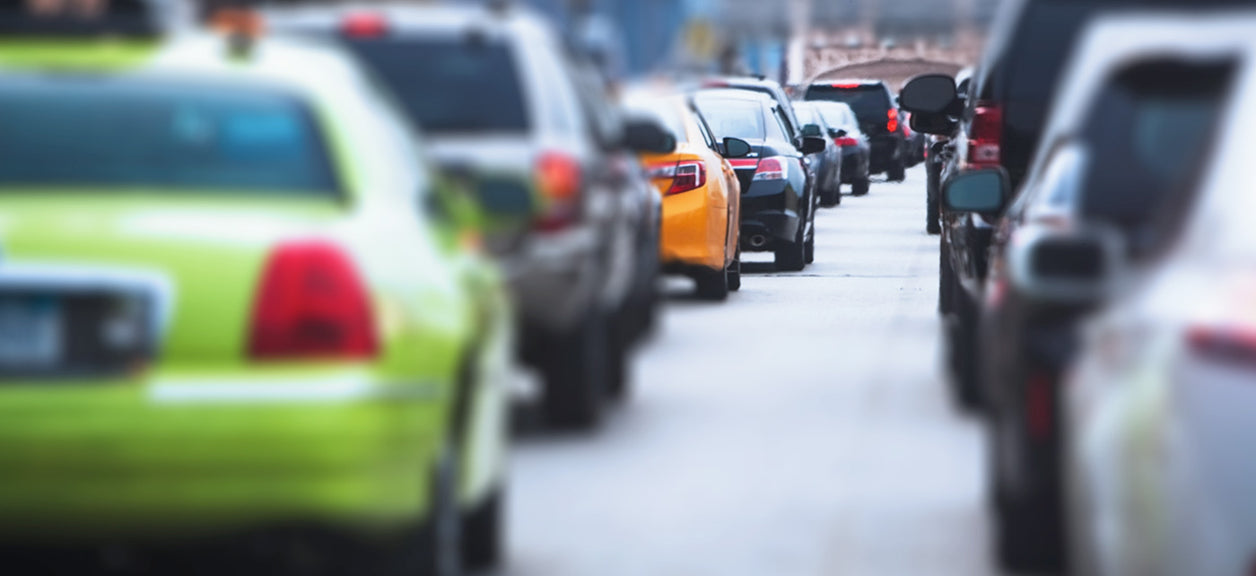
3 Strategies to Curb Auto Pollution
Today, 45 million Americans go to school, work, or live within 300 feet of a major roadway, railroad, or airport. For these millions, there’s a growing concern about the quality of air they’re breathing. Research overwhelmingly shows that cars and trains create dangerous amounts of carbon monoxide, nitrogen oxide, and fine particulate matter.
Short and long-term exposure to these and other traffic pollutants has been linked to increased risk of asthma, stroke, lung cancer, and other diseases. In fact, in the United States alone, vehicle pollution contributes to some 53,000 premature deaths each year. So officials are drafting policies and laws to decrease auto emissions.
These three strategies could help keep our our roadways (and airways) clear.
What Is Auto Pollution?
Auto pollution, also known as vehicle pollution or car pollution, refers to the release of harmful substances into the environment by motor vehicles, such as cars, trucks, and buses. These substances include:
- Carbon monoxide (CO): A toxic gas that reduces the blood's ability to carry oxygen.
- Nitrogen oxides (NOx): Contribute to the formation of smog and acid rain, and can cause respiratory issues.
- Particulate matter (PM): Small particles that can penetrate deep into the lungs and cause health problems.
- Hydrocarbons (HC): Unburned or partially burned fuel that contributes to smog formation and can be carcinogenic.
- Sulfur dioxide (SO2): Contributes to acid rain and can cause respiratory issues.
- Greenhouse gases: Carbon dioxide (CO2) and other gases that contribute to global warming and climate change.
Auto pollution is a significant contributor to air pollution, especially in urban areas with high traffic density. It can have negative impacts on human health, the environment, and the climate.
To reduce auto pollution, governments and individuals are promoting cleaner technologies, such as electric vehicles, and encouraging the use of public transportation, carpooling, and active transportation like cycling and walking.
Idling Restrictions
The average American car idles for 16 minutes each day. That may not seem like much, but consider this: Idling vehicles in the U.S. pump 93 million metric tons of carbon dioxide (or 1.6 percent of total domestic emissions) into the atmosphere every year.

Over the past few decades, more than 20 states have passed anti-idling laws that fine drivers who leave their engine running while their car is stopped at any location for more than five minutes.
In New Jersey, for example, investigators from the state Department of Environmental Protection Agency and the police can ticket passenger and commercial vehicles from $1,000 to $2,500, depending on where the vehicle is and whether or not it’s incurred prior idling tickets.
In 2008 and 2009, Boston authorities fined a bus company and a waste hauling company nearly $1 million for leaving multiple vehicles idling in company parking facilities. And more recently, the city of London has placed digital signs at the Tower Bridge asking drivers to shut off their engines when the drawbridge is raised.
Vehicle Limitations
In cities experiencing air pollution crises, officials are taking more-direct action than just cracking down on idling cars.
In New Delhi, which was recently announced as the most-polluted city in the world, officials instituted a plan earlier this year that removed half of the city’s private vehicles from the road. Cars with even- and odd-numbered license plates were only allowed in the city on alternate days. The regulation, referred to as “car rationing,” has since been lifted, but early data showed that fine particulate matter levels fell by 10 percent in its first week.
A similar even-odd scheme has been implemented in Beijing since 2008, when the city hosted the Olympics. There, air pollution decreases 21 percent on the intermittent days when rationing is active.
Sharper Emissions Monitoring
Research shows that 25 percent of cars, mostly old vehicles or ones rigged to trick inspectors, account for 90 percent of all air pollution. American officials are grappling with strategies to identify drivers and even automakers who tamper with their cars to cheat federal and state emission tests. One idea they’re testing is a roadside sensor that can determine an individual vehicle’s emissions based on its exhaust. Officials could use the sensor to flag scofflaw vehicles for an urgent inspection.
Across the pond, in Birmingham, England, trials are underway to test a similar sensor. The system is one way to identify serial polluters, and one day it could include a camera to snap offending license plates as they pass.
Coway Air Purifiers: A Solution to Indoor Pollution
While governments and individuals work to reduce auto pollution outdoors, it's essential to consider the air quality inside our homes and workplaces. Even when we're indoors, we can be exposed to harmful pollutants generated by vehicles, especially if we live or work near busy roads or highways.
Coway air purifiers offer a solution to combat indoor auto pollution. Our advanced air purification systems are designed to filter out a wide range of pollutants, including those emitted by vehicles, such as:
- Fine particulate matter (PM2.5 and PM10)
- Volatile organic compounds (VOCs)
- Nitrogen oxides (NOx)
- Carbon monoxide (CO)
By removing these harmful substances from the air, Coway air purifiers create a cleaner and healthier indoor environment. This is particularly important for individuals who are more susceptible to the effects of air pollution, such as children, the elderly, and those with respiratory conditions like asthma.
Coway air purifiers use a multi-stage filtration process, which typically includes a pre-filter, activated carbon filter, and a high-efficiency particulate air (HEPA) filter. The HEPA filter is especially effective at capturing tiny particles, including those generated by vehicle emissions.
In addition to their powerful filtration capabilities, Coway air purifiers are also known for their smart features, such as real-time air quality monitoring, automatic fan speed adjustment, and filter replacement indicators. These features ensure that the air purifier is always working optimally to provide clean, healthy air.
By investing in a Coway air purifier, you can take a proactive step in protecting yourself and your loved ones from the harmful effects of auto pollution, even when you're indoors. As we continue to work towards reducing vehicle emissions on a larger scale, air purifiers offer a practical solution for maintaining clean air in our personal spaces.
Learn more about how Airmega is changing the way we breathe, and stay up to date on the latest news by signing up for our newsletter.
Disclaimers
1Coway air purifiers have been proven to trap dust, pollen, dander, viruses and bacteria in the air based on KCL (Korea Conformity Laboratories) testing.They have been tested in a 30㎥ size chamber according to the Korea Air Cleaning Association standard (SPS-KACA 002-132:2022 Modified) to measure the 0.01㎛ size of particle removal rate. It was tested on maximum airflow speed in normal room temperature and humidity conditions. The performance may vary in the actual living environment of customers.
→ Tested with Airmega Aim, 50, 100, 150, 160, Tower AP-1216L, Mighty AP-1512HH, MightyS AP-1512HHS, 200M, Icon, IconS, 230, 240, 250, 250 Art, 250S, 300, 300S, 350, 400, 400S, 450, ProX
299.97% of viruses, bacteria, fungi and pollen were verified to be removed from the air for Coway air purifiers which have Green True HEPA™ filter applied based on the Japan Food Research Laboratories(JFRL) testing according to JEM 1467 standard.
→ Tested with Coway Airmega Mighty AP-1512HH, MightyS AP-1512HHS, 250, 250 Art, 250S, 300, 300S, 400, 400S
→ All tested by JFRL and received above result within below time.
4The concentration of ammonia, acetaldehyde and acetic acid were proven to be removed within 30 minutes by FCG Research Institute, Inc. Human Life Science Lab. It is not a demonstration result in the actual use space. Not all odors and gases may be supported. → Tested with Coway Airmega 150, 160, Mighty AP-1512HH, MightyS AP-1512HHS, 400, 400S
5The coverage area of the air purifier is based on an area where the air cleaner can make two air changes per hour (ACPH). An air change per hour translates to how many times an air purifier can clean an area, assuming the height of a ceiling to be 8 ft, in one hour. Therefore ** means two air changes per hour means that the cleaner can clean the area once every 30 minutes and * means air changes per hour means that the air purifier can clean the area once every 60 minutes.
10Terms and conditions apply. Discounts, including promotions, coupons, bundle discount and subscription discount, cannot be stacked on top of other coupons. During promotional periods, discount codes will not be able to be applied to orders. Promo codes may apply to products only—filters, accessories, and new products within 3 months of the release date are not included.
11Based on Coway R&D internal laboratory testing, activated carbon filtration was shown to remove up to 95% of ammonia odors within 40 minutes, and up to 99% of fecal odors within 20 minutes. Actual performance may vary depending on usage conditions.



























